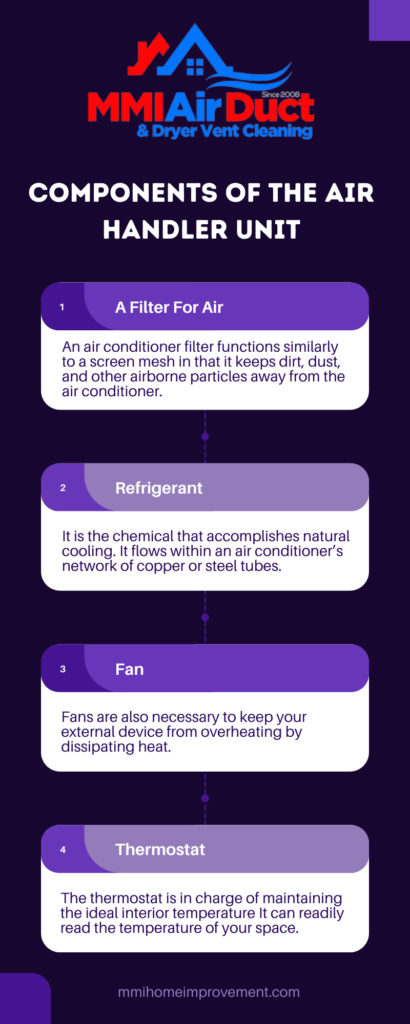An air handler unit consists of four primary parts. The four components are the evaporator, condenser, compressor, and expansion valve. Each of these AC components communicates with one another and has a particular purpose — to keep your AC functioning like a well-oiled machine.
1. Coil Of An Evaporator:
We mainly install an evaporator coil in the interior unit of a mini-split AC. Whereas, in the central unit, this coil is located in the air handler of a central system. The system’s refrigerant is cooled to a low temperature before entering the evaporator coils. When heated air from your house enters your HVAC unit, it is fanned over the cold evaporator coils, which extract heat and cool the air. Fans situated behind the evaporator coil then blow this cold air back inside, lowering the temperature of your home.
Most Companies make these coils out of Copper, although we can also make coils out of steel or aluminum. Moreover, Copper is the ideal material. Firstly, Copper has superior heat conductivity. Secondly, it is easy to maintain.
However, maintain your coils clean since dirt and dust can accumulate over time and diminish their performance. This dust can also clog the condensation drain, resulting in refrigerant leakage. While the air filter protects it, regular cleaning will help maintain your evaporator coils in good condition.
2. The Compressor:
The compressor is the workhorse of air conditioning and is perhaps the most crucial of all AC components. We normally install the compressor in the outside central and split systems unit. The compressor consumes the bulk of an air conditioner’s electricity, and it is typically the most expensive component of the system.
As the name implies, the compressor’s goal is to compress the refrigerant, which is heated vapor. It arrives at the compressor. As a result, the compressor compresses it into a hot compressed liquid.
As the air conditioning process proceeds, this is chilled and expanded to remove heat from the inside air.
The size of the compressor will vary depending on the size of your air conditioner. You can keep the most critical AC component in good working order by often checking for refrigerant leaks, preventing dirt and contamination, cleaning the condenser coils, and keeping your AC properly lubricated. Always prefer professional cleaning over DIY methods. You may approach air duct repair and replacement Atlanta.
3. Condenser Coil:
The condenser coil, located opposite the evaporator, draws heat from the refrigerant and expels it to the outside environment. You can find it in your air conditioner’s external unit.
The evaporator coil operates in the opposite direction of the condenser, with a fan blowing heat away from it. You might feel hot air coming out from your air conditioner’s outside unit if you stand outside it. The condenser emits the heat while transforming the refrigerant from hot vapor to hot liquid.
4. Valve Of Expansion:
An expansion valve is a small device that sits between the condenser and the evaporator. Because the refrigerant is now a liquid, it cannot absorb heat. After experiencing a pressure decrease, the refrigerant expands into a gas and swiftly cools in the expansion valve. This cooled gaseous refrigerant is then injected into the evaporator coils to repeat the air conditioning process.
How Do AC Parts Work Together?
Now that you’re familiar with the key components of air conditioners, it’s a good idea to understand how they all interact with one another.
Let’s begin with the cooling process. Firstly, the refrigerant is compressed and transformed into a heated, high-pressure liquid in the compressor. Secondly, This liquid flows towards the condenser coils, which are cooled by a huge fan. The expansion valve follows, swiftly expanding the refrigerant and transforming it into a chilly, low-pressure gas. This cooled gas is what keeps your room cool. All of this is happening in the evaporator coils. Lastly, When the rings get cold, a fan in the interior unit circulates warm indoor air over them, lowering the temperature.
What Are The Other Components Of The Air Handler Unit?
The building’s roof has an outside air conditioning unit. The above-mentioned AC unit components are the most important. However, there are a few more:
1. A Filter For Air:
An air conditioner filter functions similarly to a screen mesh in that it keeps dirt, dust, and other airborne particles away from the air conditioner. We can find it in the indoor unit.
2. Refrigerant:
We’ve spoken a lot about refrigerant above, and you might be wondering what it is. It is the chemical that accomplishes natural cooling. It flows within an air conditioner’s network of copper or steel tubes. Moreover, it has qualities due to which it compresses the air and extends it to cool or heat a space.
R-410A and R-22 are common refrigerants, with the latter gradually becoming outdated. For more information on AC refrigerants, see our page on them.
3. Fan:
The Air handler unit uses a fan to transport air from one component to another and blow conditioned air into your rooms. Fans are also necessary to keep your external device from overheating by dissipating heat.
4. Thermostat:
The thermostat is in charge of maintaining the ideal interior temperature. It is where you tell your AC unit what kind of cooling you desire, and it turns the AC on or off to maintain the ideal indoor temperature. It can readily read the temperature of your space because it has temperature and humidity sensors built-in.
You may regulate your AC temperature from your phone using programmable or smart thermostats, as well as establish clever instructions such as scheduling or geofencing. Suppose you have a ducted air conditioner, like a mini-split or window unit. In that case, you may utilize a smart AC controller, which functions similarly to a thermostat for central systems.

Use the below code to Embed this infographic
Common AC Component Issues
An HVAC technician inspects the air conditioner for problems. As we all know, mechanical equipment does not always want to keep running smoothly indefinitely, no matter how much we would like it to. There are numerous frequent issues with air conditioner components that might cause the AC to perform below optimally or stop operating entirely.
These issues might take many forms. Typical examples include:
- AC is emitting a noxious odor.
- Dust and debris may clog your air filter.
- The interior unit is leaking water.
- Cold air is not flowing out of the air conditioner – this is a refrigerant issue.
- Noises from the air conditioner
Aside from the discomfort, these issues may increase energy expenditures for your house. As a result, it is preferable to have them repaired as soon as possible by a skilled specialist. Immediately call commercial air duct and dryer vent cleaning Atlanta to solve all these issues. They are professional and competent.
Conclusion:
In conclusion, we can say that With your greater understanding of air conditioner components, you should be able to comprehend better how your air conditioner works. Furthermore, you are now eligible to identify any possible faults with your AC and determine when to tune up your air handler unit.
Must Read: What Is The Purpose Of HVAC Diffusers And Grilles
